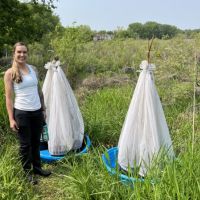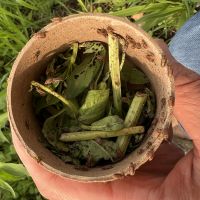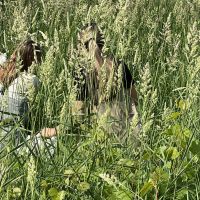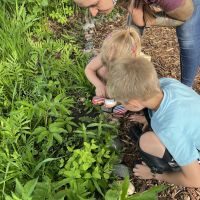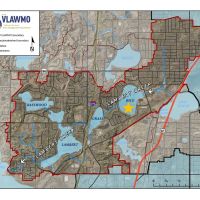Minnesota Water Steward Spotlight: Purple Loosestrife Biocontrol
Megan Sigmon-Olsen joined VLAWMO’s team of Minnesota Water Stewards in 2022. Several projects were considered for her capstone project, which is a required part of the Steward training. After evaluating options and water resource issues near to her home, Megan’s project landed on a purple loosestrife rearing effort for the Rice Lake wetland.
The first project of this kind took place at Rice Lake in 2016. Pioneered by the White Bear Townhome Association and supported by a VLAWMO grant, consultants at Fortin Consulting were contracted to introduce the loosestrife beetle population.
Why beetles?
Loosestrife beetle introduction is a biological control for wetlands across Minnesota and the country, beginning in the early 1990s. While the beetles aren’t expected to eliminate invasive purple loosestrife entirely, they aid in controlling the plant’s presence, reducing its impact on wetland function and native wildlife. The beetles introduced are a leaf-feeding beetle that has been tested to specialize in and remain focused on purple loosestrife as a key part of their life cycle. Visit the MN DNR for more information, background, and links on this method of biological control.
What’s the issue with Purple Loosestrife?
Purple Loosestrife can appear as an attractive flower providing wetlands with seasonal color, but it is ultimately an invasive species. Impacts of purple loosestrife include outcompeting native aquatic plants and creating dense root systems that alter wetland hydrology. A reduced presence of purple loosestrife in Rice Lake supports Rice Lake’s water storage contribution to the larger Lambert Creek drainage system.
For more on purple loosestrife, click here.
Capstone project description
Loosestrife beetle populations occasionally need support to sustain their populations. Winters and other environmental conditions can hinder the population as purple loosestrife becomes reestablished. Since the original 2016 beetle population had declined, Megan’s efforts were in good time. VLAWMO staff helped Megan connect with the former 2016 consultants that helped with the project, and soon she was trained in on loosestrife beetle rearing. Beetle rearing and release took place in June-July, 2023.
Beetle rearing is a technique to capture beetles and improve their reproductive success. It can be a technique to re-release the reared beetles in the same wetland, or to introduce beetles to a new wetland. This is a permitted activity requires training and collaboration with invasive species specialists. View this PDF for more on beetle rearing.
To complete her capstone project, Megan shared the effort with neighbors at the 2023 National Night Out on August 1st.
Visit @Life_on_rice_lake_wbl on Instagram for more stories and posts on the project.

